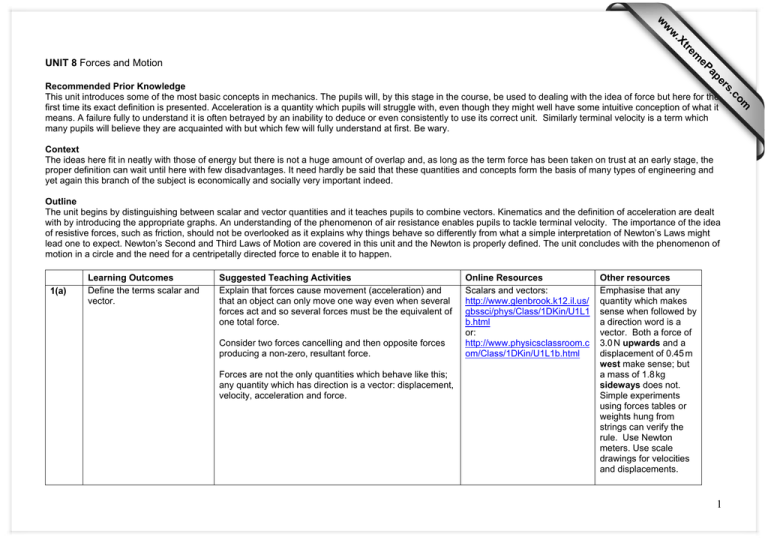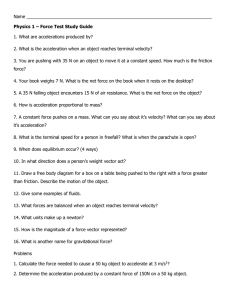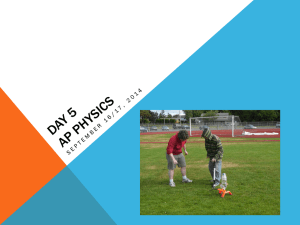www.XtremePapers.com UNIT 8
advertisement

m e tr .X w w w Recommended Prior Knowledge This unit introduces some of the most basic concepts in mechanics. The pupils will, by this stage in the course, be used to dealing with the idea of force but here for the first time its exact definition is presented. Acceleration is a quantity which pupils will struggle with, even though they might well have some intuitive conception of what it means. A failure fully to understand it is often betrayed by an inability to deduce or even consistently to use its correct unit. Similarly terminal velocity is a term which many pupils will believe they are acquainted with but which few will fully understand at first. Be wary. Context The ideas here fit in neatly with those of energy but there is not a huge amount of overlap and, as long as the term force has been taken on trust at an early stage, the proper definition can wait until here with few disadvantages. It need hardly be said that these quantities and concepts form the basis of many types of engineering and yet again this branch of the subject is economically and socially very important indeed. Outline The unit begins by distinguishing between scalar and vector quantities and it teaches pupils to combine vectors. Kinematics and the definition of acceleration are dealt with by introducing the appropriate graphs. An understanding of the phenomenon of air resistance enables pupils to tackle terminal velocity. The importance of the idea of resistive forces, such as friction, should not be overlooked as it explains why things behave so differently from what a simple interpretation of Newton’s Laws might lead one to expect. Newton’s Second and Third Laws of Motion are covered in this unit and the Newton is properly defined. The unit concludes with the phenomenon of motion in a circle and the need for a centripetally directed force to enable it to happen. 1(a) Learning Outcomes Define the terms scalar and vector. Suggested Teaching Activities Explain that forces cause movement (acceleration) and that an object can only move one way even when several forces act and so several forces must be the equivalent of one total force. Consider two forces cancelling and then opposite forces producing a non-zero, resultant force. Forces are not the only quantities which behave like this; any quantity which has direction is a vector: displacement, velocity, acceleration and force. Online Resources Scalars and vectors: http://www.glenbrook.k12.il.us/ gbssci/phys/Class/1DKin/U1L1 b.html or: http://www.physicsclassroom.c om/Class/1DKin/U1L1b.html Other resources Emphasise that any quantity which makes sense when followed by a direction word is a vector. Both a force of 3.0 N upwards and a displacement of 0.45 m west make sense; but a mass of 1.8 kg sideways does not. Simple experiments using forces tables or weights hung from strings can verify the rule. Use Newton meters. Use scale drawings for velocities and displacements. 1 om .c s er ap eP UNIT 8 Forces and Motion 1(b) 1(c) Learning Outcomes Determine the resultant of two vectors by a graphical method. Suggested Teaching Activities Consider two forces which are perpendicular and add them graphically. Introduce the parallelogram rule and the triangle of forces. List the vectors and scalars from distance, displacement, length, speed, velocity, time, acceleration, mass and force. The distinctions between distance and displacement or between speed and velocity are arbitrary conventions in physics which have to be learnt. Online Resources Vector addition: http://www.physchem.co.za/Ve ctors/Addition.htm Other resources Acceleration: http://www.glenbrook.k12.il.us/ gbssci/phys/Class/1DKin/U1L1 e.html or http://library.thinkquest.org/10 796/ch3/ch3.htm Introduce the unit m/s² and consider objects falling from cliffs; notice that they travel further in each subsequent second. Use 10 m/s² to calculate the velocities and displacements for falling objects. They are conveniently illustrated by estimating them for a racing car travelling at uniform speed at various points around a racing track – especially after a whole number of laps. 2(e)1 Plot and interpret distancetime graphs. Consider the distance-time graph and take its gradient. 2(e)2 Plot and interpret speed-time graphs. Pupils often find rates of anything difficult. Plot graphs of pupil’s height → time or volume of water in bath → time or any quantity with a single unit → time. Talk about metres/year, litres/minute or somethings/second. With a flying start, measure the time for a pupil to run or bicycle 10 m, 20 m, 30 m etc. and plot distance → time graphs. Consider a motorbike moving away from the traffic lights, its velocity is increasing. The rate will be measured in (m/s)/s. Consider numerical values. Calculate a. 2(c) State what is meant by uniform acceleration and calculate the value of an acceleration using change in velocity/time taken. 2(h) State that the acceleration of free-fall for a body near the Earth is constant and is approximately 10 m/s². Calculate the gradient of a speed-time graph. Consider the distance-time graph of an accelerating body. Run across the classroom accelerating from rest. Then decelerate. For a uniformly accelerating object the average velocity = (u+v)/2. Freefall: http://solomon.physics.sc.edu/ ~tedeschi/demo/demo3.html or 2 Learning Outcomes 2(e)3 Plot and interpret distancetime graphs. 2(i) Describe qualitatively the motion of bodies with constant weight falling with and without air resistance (including reference to terminal velocity). Suggested Teaching Activities An object reaching terminal velocity is a good example to consider. Emphasise the distinction between a decreasing acceleration and a deceleration (negative acceleration). Online Resources http://www.glenbrook.k12.il.us/ gbssci/phys/Class/newtlaws/u 2l3e.html Other resources Speed-time graphs: http://www.physicsclassroom.c om/Class/1DKin/U1L3a.html or: http://www.bbc.co.uk/schools/ gcsebitesize/physics/forces/sp eedvelocityaccelerationfhrev2. shtml Terminal velocity: http://www.bbc.co.uk/schools/ gcsebitesize/physics/forces/fall ingobjectsrev2.shtml Consider the motion of a falling parachutist. Set up a tube containing a viscous liquid and drop ball-bearings into it. Or consider a rocket which accelerates at an increasing rate as its mass decreases (F = ma is dealt with later). Consider the speed-time graph in both cases. 2(d) Discuss non-uniform acceleration. 2(f) Recognise from the shape of a speed-time graph when a body is (1) at rest, (2) moving with uniform speed, (3) moving with uniform acceleration, (4) moving with non-uniform Non-uniform acceleration: http://homepage.mac.com/cba kken/weblabs/nonuniform.html Make sure that distance-time and speed-time graphs and their gradients are understood. Set up a large pendulum (l ~ 3 m) and observe its motion; try to plot an approximate speed-time graph. 3 2(g) 3(a) Learning Outcomes acceleration. Suggested Teaching Activities Online Resources Calculate the area under a speed-time graph to determine the distance travelled for motion with uniform speed or uniform acceleration. Pupils will probably be able to use the formula x = vt in ordinary situations – when travelling for 3 h at 5 km/h one moves 15 km. Use these ideas in the case of a speed-time graph for a body moving at constant speed. Area under the graph: http://www.bbc.co.uk/scotland/ education/bitesize/standard/ph ysics/forces_and_motion/spee d-time_graphs_rev3.shtml State Newton’s third law. Emphasise that forces only ever occur in pairs; single forces never exist. The horse pulls the cart, the cart restrains the horse. Emphasise that area does not mean cm² of graph paper but area according to the two axes. This has unit of m/s × s: m. Suspend a hook from a support or the ceiling by friction alone. Suspend a weight from the hook. Gradually increase the weight supported. The third law: http://www.glenbrook.k12.il.us/ gbssci/phys/Class/newtlaws/u 2l4a.html or: http://www.physchem.co.za/M otion/Third%20Law.htm Emphasise that two third law forces never act on the same body. The forces are always of the form: the force on A due to B and the force on B due to A: BFA = - AFB Two forces acting on the same body may well be equal in size, opposite in direction and of the same nature, but they cannot be a third law pair. Friction free motion: http://www.bbc.co.uk/schools/s cienceclips/ages/8_9/friction.s html or: http://www.fearofphysics.com/ Friction/friction.html Examples of zero resultant force acting on a stationary body are numerous. As the hook exerts a larger force on the weight, the weight exerts a larger force on the hook which is eventually pulled from its support. 3(c) Describe the ways in which a force may change the motion of a body. Other resources Get two pupils to lean against each other back to back at an angle. As A supports B, so B supports A. Stand a pupil on a set of scales. As the weight pushes down on the scales and is recorded, so the scales push upwards on the pupil, who does fall to the floor but stays a few centimetres (the thickness of the scales) above it. A body experiencing no resultant force will have zero acceleration (constant velocity, but not necessarily zero velocity). Consider: ice-hockey pucks, snooker balls, maglev trains, hovercraft and space-craft. The Voyager probes are still travelling in straight lines at huge velocities long after their engines stopped working. The School resting on its foundations, a book resting on a table, an exhausted athlete lying on a trampoline (here 4 Learning Outcomes Suggested Teaching Activities 3(b) Describe the effect of balanced and unbalanced forces on a body. Get the pupils to contribute as many appropriate words as possible: speeding up, slowing down, stopping, changing direction, reversing, swerving, lifting and so on. 3(d) Do calculations using the equation force = mass x acceleration. Show that acceleration is the consequence of a resultant force. Pull a trolley along a track using a falling weight and a pulley. Online Resources Other resources the stretching of the support can be noticed; in the other two cases it is too small to observe). F = ma: http://www.bbc.co.uk/schools/ gcsebitesize/physics/forces/fe qmahrev2.shtml If possible use tickertape timers, (or dataloggers) and trolleys to show: a α F and a α 1/m. So F = kma but that in SI k =1; this defines the Newton. 3(e) Explain the effects of friction on the motion of a body. Emphasise that the consequence of a constant, resultant force is a constant acceleration not a constant velocity. 3(f) Discuss the effects of friction on the motion of a vehicle in the context of tyre surface, road conditions (including skidding), braking force, braking distance, thinking distance and stopping distance. Emphasise that when cars, trains and aeroplanes are travelling at constant velocity, the tractive force is used to cancel frictional forces. Stopping distances: http://www.sdt.com.au/STOPP INGDISTANCE.htm Consider the effect of reducing or increasing friction between the road and vehicle: oil spills and ice on roads or gravelled escape lanes for lorries on steep hills. Consider the effect of reduced visibility (night, fog, rain) or the driver’s condition (intoxication, tiredness, lack of concentration). 3(g) Describe qualitatively motion in a circular path due to a constant perpendicular force, including electrostatic forces on an electron in an atom and gravitational forces on a Pass a thin piece of string (~50 cm) through a narrow length of glass tubing. Attach an object (small ball) to one end of the string and a laboratory weight to the other end. Hold the tube and set the object moving in a circle; a balance is reached when the weight supplies the correct tension in the string to keep the object moving in a circle. Centripetal motion: http://www.glenbrook.k12.il.us/ gbssci/phys/mmedia/circmot/cf .html Relate these ideas to the force needed to keep a moving electron in a circular orbit or a moving satellite in orbit around the Earth. The 5 Learning Outcomes satellite (F = mv²/r is not required). Suggested Teaching Activities Online Resources Cut the string and observe the object fly off in a tangential direction. Make sure that the object moves in a safe direction and that no one is injured. A force is needed for circular motion and when it is removed, the object reverts to straight line motion with constant velocity. Consider a motorbike travelling around a curve hitting a patch of spilled oil. The removal of friction allows the motorbike to carry on in a straight line and to hit the outside of the curve. Consider: a spin-drier, a bucket of water rotated in a vertical circle, holding on to a roundabout or throwing the hammer in athletics. 3(h) Discuss how ideas of circular motion are related to the motion of the planets in the solar system. Other resources word centripetal – if used at all – must be used as a direction word (just like downwards). Gravitational and electrostatic attractions are forces of physics which in these cases act in a centripetal direction. Electrons: http://www.colorado.edu/physi cs/2000/waves_particles/wavp art2.html 6


